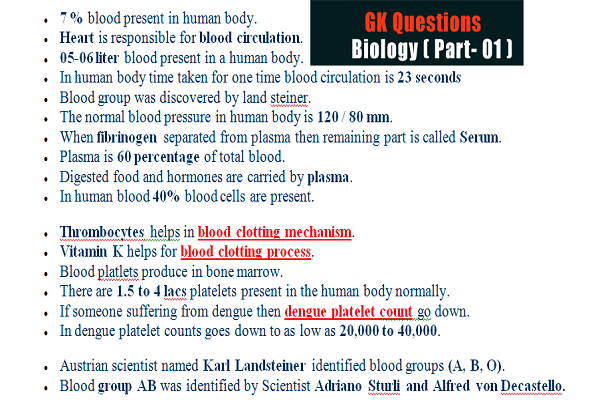
Best Rakt 50 Blood Related Facts: Blood Groups, Platelets, Blood Cells
Rakt 50 Blood Related Facts: Vitamin K helps for blood clotting. Anemia produced due to lack of haemoglobin. Iron is present in hemoglobin. RBC carry oxyzen and remove Co2 from body.
Blood (Rakt 50 Blood Related Facts)
- In plasma all three blood cells floats.
- Blood called as fluid connective tissue.
- 7 % blood present in human body.
- Heart is responsible for blood circulation.
- 05-06 liter blood present in a human body.
- In human body time taken for one time blood circulation is 23 seconds
- Blood group was discovered by land steiner.
- The normal blood pressure in human body is 120 / 80 mm.
- When fibrinogen separated from plasma then remaining part is called Serum.
- Plasma is liquid part of blood.
- Plasma is 60 percentage of total blood.
- Digested food and hormones are carried by plasma.
- In human blood 40% blood cells are present.
- Three types of blood cells are- Red Blood Cells (RBC), White Blood Cells (WBC), and Platelet.
Red Blood Cells (Rakt 50 Blood Related Facts)
- A protein (Haemoglobin) present in Red Blood Cells.
- Iron is present in hemoglobin.
- Approximately 50,00000/ML3 Red Blood Cells present in the human body.
- RBC (Red Blood Cells) produced in bone marrow in normal condition.
- In fetus condition RBC created in lever.
- The life period of RBC is 20-120 days.
- RBC destroyed in liver.
- The reason of red color of blood is hemoglobin.
- Haeme is responsible for red color of RBC.
- Iron is present in haeme which combines with oxyzen and produce red colour.
- Anemia produce due to lack of haemoglobin.
- In sleeping state RBC decrease upto 5 %.
- In 4200 mitre hight RBC increases by 30 %.
- RBC carry oxyzen and remove Co2 from body.
White blood cells (Rakt 50 Blood Related Facts)
- White blood cells (WBC) or leucocyte fight against infection and provide immunity system.
- The shape of White blood cell is like Ameba.
- The life period of WBC is 01-04 days.
- The ratio of RBC and WBC in human body is 600 : 1.
Platelets (Thrombocytes)
- Platelets or thrombocytes play an important role in stopping blood bleeding.
- Thrombocytes helps in blood clotting mechanism.
- Vitamin K helps for blood clotting process.
- Blood platlets produce in bone marrow.
- The life period of platlets ic 03-05 days.
- There are 1.5 to 4 lacs platelets present in the human body normally.
- If someone suffering from dengue then dengue platelet count go down.
- In dengue platelet counts goes down to as low as 20,000 to 40,000.
Blood Groups
- Austrian scientist named Karl Landsteiner identified blood groups (A, B, O).
- Scientist Karl Landsteiner achieved Nobel prize in 1930 for this classification of blood.
- Blood group AB was identified by Scientist Adriano Sturli and Alfred von Decastello.
- O type of blood group person can donate to all blood group person.
- Karl Landsteiner and Alexander S. Wiener discovered Agglutinogen protein.
- Agglutinogen protein present in Arhesus monkey. So, Landsteiner and Wiener gave a name that Rh factor.
- People who have Rh factor are said to be Rh+ and people who don’t have Rh are said to be Rh-.
- During the birth of a child, a child gets the Erythroblastosis Fetalis disease due to Rh antigen.
- When a father is Rh+ and mother is Rh-, then erythroblastosis fetalis disease takes place.
- AB+ blood group is the universal recipient of blood,
- In blood group A red blood cell contains “A” antigen and plasma contains antibody “b”.
- Red blood cell in blood group B contains “B” antigen and plasma contains antibody “a”.
- In blood group AB red blood cell contains both “A” & “B” antigen (but plasma does not contain antibody “a” and “b”).
- In blood group O both antibody “a” and “b” present in plasma (but antigen “A” or “B” not present in the red blood cell).
- O negative is the universal donor.
- In besides to the A and B antigens, there is a third antigen called the Rh factor.
- In general, Rh-negative blood is provided to Rh-negative patients, and Rh (+) blood or Rh (-) blood may be provided to Rh (+) patients.
